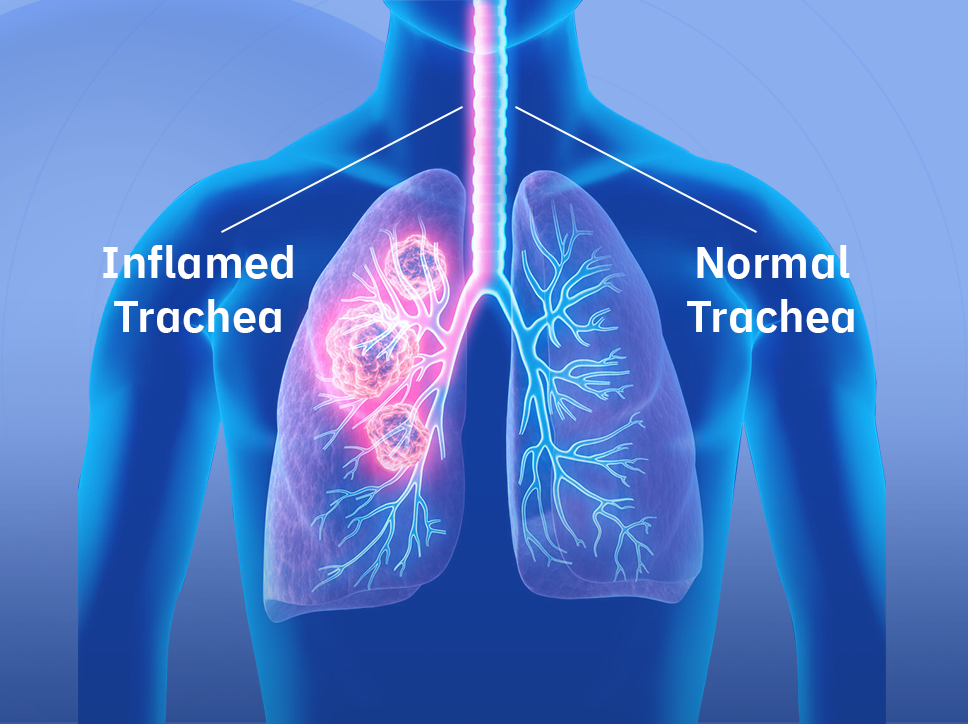


Tracheitis is a condition that affects the trachea, also known as the windpipe—a hollow muscular tube that extends from the larynx down to the lungs, running parallel to the esophagus. It measures approximately 13 cm in length and 2.5 cm in diameter. Structurally, it consists of several C-shaped cartilage rings that provide the flexibility needed when food passes through the esophagus.
The trachea serves as a vital link between the upper and lower respiratory tracts. At its lower end, it branches into two bronchi—commonly referred to as the primary bronchi—which act as the bridge connecting the trachea to the lungs.
However, the trachea can become inflamed, leading to a condition known as Tracheitis, which may impair its critical functions and result in complications. In this article, we’ll explore the functions of the trachea, the signs and causes of tracheal inflammation, and the most effective treatments.

The trachea plays a central role in the respiratory process due to its anatomical position. Its main functions include:
The trachea acts as a passageway that carries air from the nose or mouth to the lungs during inhalation and expels carbon dioxide from the lungs during exhalation.
Its inner lining consists of epithelial tissue containing mucus-secreting glands. This mucus helps regulate the temperature of inhaled air—cool air is warmed, and hot air is moistened—before it reaches the lungs, thereby protecting the respiratory system.
Alongside the vocal cords, the trachea assists in sound production. Airflow from the lungs through the trachea helps move the vocal cords, facilitating voice generation.
The trachea safeguards the lungs from foreign particles through several mechanisms:
Epithelial Lining: Produces sticky mucus that traps dust, pathogens, and other foreign particles.
Cilia: These hair-like structures push trapped particles upward toward the throat, triggering a cough reflex or directing them to the esophagus to be swallowed.
Epiglottis: Closes over the trachea during swallowing, preventing food or drink from entering the airway.
Tracheitis is a common respiratory condition characterized by inflammation of the tracheal lining, resulting in:
Can be dry or productive, often accompanied by chest discomfort, and may worsen at night.
Caused by difficulty breathing due to inflammation and narrowed airways.
A high-pitched whistling sound during breathing due to airway obstruction.
Signifying the body’s immune response to infection.
May occur if breathing difficulties interfere with eating and appetite.
Tracheitis can result from various causes, including:
A hereditary condition leading to mucus buildup in the airways and lungs, causing chronic Tracheitis and breathing difficulty.
Bacterial or viral infections are among the primary causes.
Triggered by inhaling irritants such as smoke, steam, dust, or pollen.
Stomach acid reflux may cause irritation and inflammation in the trachea, leading to Tracheitis.
Untreated or chronic Tracheitis may lead to serious complications, such as:
Untreated or chronic Tracheitis may lead to serious complications, such as:
Severe inflammation can restrict airflow, requiring emergency medical intervention.
Persistent tracheal inflammation leading to long-term respiratory issues.
A rare but serious condition indicating blood vessel rupture within the trachea.
Accumulation of pus in the lungs, causing chest pain and productive cough.
Treatment varies based on the underlying cause and may include:
Prescribed if the Tracheitis is caused by bacterial infection.
Help open the airways and improve breathing.
Help open the airways and improve breathing.
Help reduce fever and manage discomfort.
While genetic causes cannot be prevented, the following steps can reduce the risk of Tracheitis:
Vaccinations: Protect against infections that may lead to tracheal inflammation (e.g., pertussis, measles).
Avoid Irritants: Minimize exposure to smoke, fumes, and other allergens.
Tracheitis is more than just a temporary respiratory irritation—it can lead to severe and potentially life-threatening complications if neglected. That’s why visiting an ENT specialist is crucial for proper diagnosis and timely treatment.

استشاري الأنف والأذن والحنجرة
CONSULTANT OF EAR, NOSE AND THROAT

انضم الدكتور صالح صقر العمري، استشاري الأنف والأذن والحنجرة، ذو الخبرة الواسعة في اضطرابات قناة استاكيوس والطنين، إلى فريق عيادات سفن الطبية.
يقدم المركز بيئة متكاملة تجمع بين أحدث تقنيات التشخيص، وعيادات متخصصة في التخاطب والسمعيات، إضافة إلى حلول السماعات الطبية المصممة لتحسين جودة الحياة.
للتواصل و حجز موعد
نرحب بكم ونسعد بخدمتكم.
0539113777